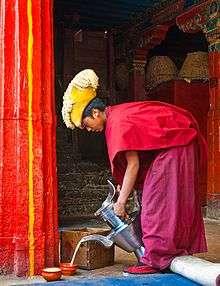Butter tea
|
Tibetan Monk churning butter tea | |
| Alternative names | Po cha, cha süma, goor goor cha, cha suskan |
|---|---|
| Type | Beverage |
| Place of origin | Tibet and China |
| Main ingredients | Tea leaves, yak butter, salt |
|
| |
Butter tea, also known as po cha (Tibetan: བོད་ཇ་, Wylie: bod ja , "Tibetan tea"), cha süma (Tibetan: ཇ་སྲུབ་མ་, Wylie: ja srub ma , "churned tea"), Mandarin Chinese: sūyóu chá (酥油茶) or gur gur in the Ladakhi language, is a drink of the people in the Himalayan regions of Nepal, Bhutan, India (particularly in Ladakh, Sikkim) and, most famously, Tibet.
Traditionally, it is made from tea leaves, yak butter, water, and salt, although butter made from cow's milk is increasingly used, given its wider availability and lower cost.
Customs


Drinking butter tea is a regular part of Tibetan life. Before work, a Tibetan will typically enjoy several bowlfuls of this beverage, and it is always served to guests. Since butter is the main ingredient, butter tea provides plenty of caloric energy and is particularly suited to high altitudes. The butter may also help prevent chapped lips.[1]
According to the Tibetan custom, butter tea is drunk in separate sips, and after each sip the host refills the bowl to the brim. Thus, the guest never drains his bowl; rather, it is constantly topped up. If the visitor does not wish to drink, the best thing to do is leave the tea untouched until the time comes to leave and then drain the bowl. In this way etiquette is observed and the host will not be offended.[2]
Butter tea is also used for eating tsampa by pouring onto it, or dipping the tsampa into it, and mixing well.
The concentrate, produced by repeatedly boiling tea leaves, will keep for several days, and is commonly used in towns. The tea is then combined with salt and butter in a special tea churn (Tibetan: མདོང་མོ་, Wylie: mdong mo ), and churned vigorously before serving hot. Now an electric blender is often used.
History
While evidence of tea has been found in Tibet from before the 10th century, it did not reach its nearly universal status until about the 13th century, the time of the Sakya hierarchy and the Phagmodu kings.
Preparation
The highest quality tea is made by boiling the tea leaves in water for half a day, achieving a dark brown color. It is then skimmed, and poured into a cylinder with fresh yak butter and salt which is then shaken. The result is a purplish liquid that is about the thickness of a stew[2] or thick oil. It is then poured into clay tea-pots, or jars, that resemble Japanese teapots.[3]
Another method is to boil water, and add handfuls of the tea into the water, which is allowed to steep until it turns almost black. Salt is then added, along with a little soda if wanted. The tea is then strained through a horse-hair or reed colander into a wooden butter churn, and a large lump of butter is added. This is then churned until the tea reaches the proper consistency and transferred to copper pots that sit on a brazier to keep them warm. When a churn is not available, a wooden bowl and rapid stirring will suffice.[4]
Nowadays, when tea leaves, yak butter and wooden butter churns are not available, people often make butter tea using tea bags, different types of butter available in the market and a blender to churn.[5][6]
See also
References
Citations
- ↑ Mayhew, Bradley and Kohn, Michael. (2005) Tibet. 6th edition, p. 75. ISBN 1-74059-523-8.
- 1 2 Chapman, F. Spencer. (1940). Lhasa the Holy City, pp. 52-53. Readers Union Ltd., London.
- ↑ Kawaguchi, Ekai (1909): Three Years in Tibet, pp. 325-326. Reprint: Book Faith India (1995), Delhi. ISBN 81-7303-036-7.
- ↑ Tibetan Marches. André Migot. Translated from the French by Peter Fleming, pp. 102-3. (1955). E. P. Dutton & Co. Inc. New York.
- ↑ "Sherpa Butter Tea".
- ↑ "Yak Butter Tea".
Sources
- Forbes, Andrew ; Henley, David (2011). 'Tibetan Butter Tea' in: China's Ancient Tea Horse Road. Chiang Mai: Cognoscenti Books. ASIN: B005DQV7Q2.
- Richtsfeld, Bruno: Tee und Teekultur in Tibet. In: Markus Mergenthaler (ed.): TeeWege. Historie / Kultur / Genuss. Dettelbach 2013. p. 28-77.
- Waddell, L. Austine. 1895. Tibetan Buddhism: With Its Mystic Cults, Symbolism and Mythology, and in Its Relation to Indian Buddhism. W. H. Allen & Co., London. Reprint 1972: Dover Publications, New York. ISBN 0-486-20130-9. For a good description of how tea was served in monasteries, see pp. 191–192; 214-217 (with illustration).
- Tibetan Tea and Its Tradition
External links
| Wikibooks Cookbook has a recipe/module on |
| Wikimedia Commons has media related to Butter tea. |
- Example of bowls from which Tibetans drink tea and further information on the bowls custom
- Sherpa Butter Tea